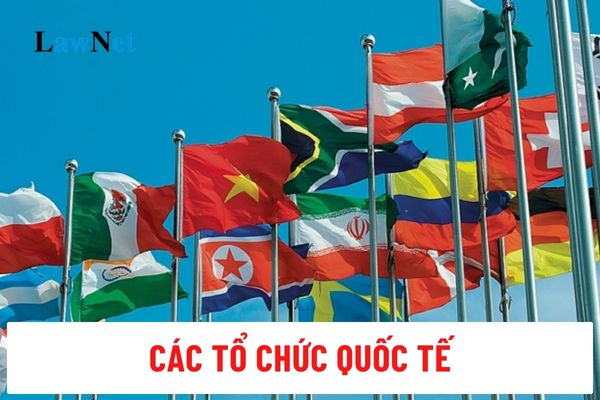What are abbreviations and full names of international organizations that are commonly used in Vietnam?
What are abbreviations and full names of international organizations that are commonly used in Vietnam?
Some abbreviations and full names of international organizations commonly used in Vietnam are as follows:
| Abbreviation of International Organizations | Full Name in English | Full Name in Vietnamese |
| AFC | Asian Football Confederation | Liên đoàn bóng đá châu Á |
| APEC | Asia-Pacific Economic Cooperation | Diễn đàn hợp tác kinh tế châu Á - Thái Bình Dương |
| ASEAN | Association of Southeast Asian Nations | Hiệp hội các quốc gia Đông Nam Á |
| CIA | Central Intelligence Agency | Cục Tình báo Trung ương Mỹ |
| FAO | Food and Agriculture Organization | Tổ chức Lương thực và Nông nghiệp Liên Hợp Quốc |
| FBI | Federal Bureau of Investigation | Cục điều tra Liên bang Mỹ |
| IAEA | International Atomic Energy Agency | Cơ quan Năng lượng Nguyên tử Quốc tế |
| ICC | International Chamber of Commerce | Phòng Thương mại Quốc tế |
| IMF | International Monetary Fund | Quỹ Tiền tệ Quốc tế |
| OECD | Organisation for Economic Co-operation and Development | Tổ chức Hợp tác và Phát triển Kinh tế |
| OPEC | Organization of the Petroleum Exporting Countries | Tổ chức Các nước Xuất khẩu Dầu mỏ |
| UEFA | The Union of European Football Associations | Liên đoàn bóng đá châu Âu |
| UN | United Nations | Liên Hợp Quốc |
| UNESCO | The United Nations Educational, Scientific and Cultural Organization | Tổ chức Giáo dục, Khoa học và Văn hoá của Liên Hợp Quốc |
| UNICEF | The United Nations Children's Fund | Quỹ Nhi đồng Liên Hợp Quốc |
| WB | World Bank | Ngân hàng Thế giới |
| WTO | World Trade Organization | Tổ chức Thương mại Thế giới |
| WHO | World Health Organization | Tổ chức Y tế Thế giới |

What are abbreviations and full names of international organizations that are commonly used in Vietnam? (Image from the Internet)
Which grade will students learn the abbreviations and full names of international organizations in Vietnam?
Vietnamese language knowledge for grade 9 Literature is stipulated under sub-section 2 Section 5 of the General Education Program for Literature issued with Circular 32/2018/TT-BGDDT as follows:
- The difference in meaning of some Sino-Vietnamese elements that are easily confused (e.g., đồng in đồng dao, đồng âm, đồng minh; minh in thanh minh, minh oan, u minh)
- Allusions (e.g., The Cowherd and the Weaver Girl, Tái ông thất mã (The old man lost his horse)): characteristics and effects
- The meaning and usage of abbreviations of important international organizations (such as UN, UNESCO, UNICEF, WHO, WB, IMF, ASEAN, WTO, etc.)
- Transforming and expanding sentence structures (reordering sentence components, adding supplementary components, etc.): characteristics and effects
- Selecting simple sentences - compound sentences, types of compound sentences, conjunctions to connect clauses in compound sentences
- Elliptical and special sentences: characteristics and functions
- Rhetorical devices like puns, alliteration, and rhyme repetition: characteristics and effects
- The difference between direct and indirect speech; the use of punctuation in direct and indirect speech
- Types and genres of texts
+ Narrative texts: storytelling, simulating a previously read story; storytelling adapting content from a comic
+ Expressive texts: eight-syllable poems; paragraphs expressing thoughts on an eight-syllable poem
+ Argumentative texts: the role of the thesis, reasoning, and evidence in presenting the content of argumentative texts; argumentative essays presenting issues and solutions; analysis essays on a literary work
+ Informational texts: how to present ideas and information in texts; the expressive effectiveness of non-linguistic means in informational texts; explanatory texts on a social phenomenon; descriptive texts about a landmark or historical site; advertisements, brochures
- Some notes on citation to avoid plagiarism
- The development of language: new words and new meanings
- Basic knowledge about Vietnamese scripts: chữ Nôm and chữ Quốc ngữ
- Non-verbal communication means: images, numbers, charts,...
Grade 9 students will learn the abbreviations and full names of international organizations according to the latest curriculum.
What level is grade 9 in Vietnam?
Based on the provisions of Clause 1, Article 28 of the Education Law 2019:
Levels and ages in general education
1. The levels and ages in general education are prescribed as follows:
a) Primary education is conducted over 5 school years, from grade one to the end of grade five. The age of students entering grade one is 6 years old and calculated by year;
b) Lower secondary education is conducted over 4 school years, from grade six to the end of grade nine. Students entering grade six must have completed the primary program. The age of students entering grade six is 11 years old and calculated by year;
c) Upper secondary education is conducted over 3 school years, from grade ten to the end of grade twelve. Students entering grade ten must have a lower secondary graduation diploma. The age of students entering grade ten is 15 years old and calculated by year.
Based on the above regulation, lower secondary education is generally conducted over 4 school years, from grade 6 to the end of grade 9 (Except for some special cases).
Therefore, grade 9 falls under lower secondary education; grade 9 students are lower secondary students.

